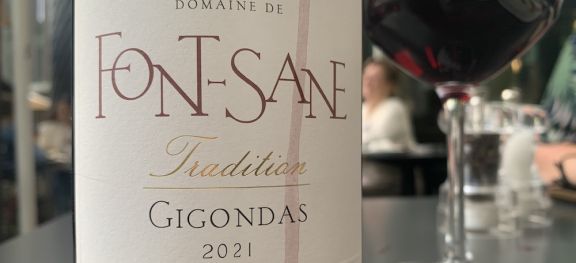Domaine de Font-Sane, Tradition 2021 Gigondas

A red that isn't worth waiting for, in the best possible way. As you can see from Richard's photo above, he was so eager to drink it, he dribbled it.
2021 vintage from $22.98, €20.98, 159 Danish kroner
2020 vintage from 544 Czech koruna, $27.99, AU$44, £26.95
One of the biggest misconceptions about wine is that older bottles are better. The gloriously youthful 2021 vintage of Domaine de Font-Sane's Tradition Gigondas is absolute proof that isn't true: this is a wine to relish as soon as you can for its exuberance, vigour and sheer loveliness.
The reasons why wine doesn't always improve with age are straightforward. The great majority of wine sold in the world is made to drink on release, and therefore lacks the requisite concentration and structure for maturing in bottle.
As for fine wine that does have the capacity to age, far too much of it is left in cellars to die. Any wine collector knows the guilt of buying wine that goes undrunk. Perhaps the original intention was to sell it on, although as someone who is offered unwanted bottles on a daily basis (as part of my day job for 67 Pall Mall in Singapore), I am conscious of a surfeit of wine on the open market, despite what burgundy prices suggest.
Either way, far too many bottles are left to linger until it's too late. And letting wine become undrinkably old is surely more of a crime than drinking it 'too young'.
Which brings us back to the Dom de Font-Sane, Tradition 2021 Gigondas, which I drank at the Kings Cross branch of Vinoteca in London over dinner last month. It was all the things that make southern Rhône reds great: fiery red fruit, savoury complexity like hot tarmac, full body and wholegrain tannins. Too young? Are the first buds of spring too young? Are kittens and puppies too young?
Okay okay, they all have potential for growth, but sometimes the appeal of youth is too much to resist.
The wine is around three-quarters Grenache, blended with almost a quarter of Syrah, plus smaller amounts of Mourvèdre and Cinsault. The relatively high percentage of Syrah might explain why I like it so much. I gave 17.5 to the 2018 vintage, while Ali Cooper and James Lawther MW respectively gave 16.5+ and 17 to the two subsequent vintages – all of them reviewed within a year of vintage, I note. This suggests that the wine is consistently impressive when young, and refutes the idea that such wines need bottle age for the structure to 'integrate'. In fact, wines that are unbalanced when young tend to be unbalanced when old. This Gigondas, like so many Grenache-based reds, doesn't have the obdurate tannins of young Cabernet Sauvignon nor the austere fruit of young Nebbiolo.
It was the ideal accompaniment to seared duck breast, and as a youthful, full-bodied red with 14.5% alcohol it is certainly built to accompany hearty food.
According to Wine-Searcher.com the 2021 vintage is available in the US, across the Eurozone and in Denmark. Czech, Australian and British retailers are apparently still selling through the 2020 vintage so admired by James. Elsewhere, vintages back to 1994 are still available … but why would you want those?
For more about the 2021 vintage in the Rhône, see this collection of articles.
Become a member to view this article and thousands more!
- 15,423 featured articles
- 274,424 wine reviews
- Maps from The World Atlas of Wine, 8th edition (RRP £50)
- The Oxford Companion to Wine, 5th edition (RRP £50)
- Members’ forum
- 15,423 featured articles
- 274,424 wine reviews
- Maps from The World Atlas of Wine, 8th edition (RRP £50)
- The Oxford Companion to Wine, 5th edition (RRP £50)
- Members’ forum
- Commercial use of our Tasting Notes

